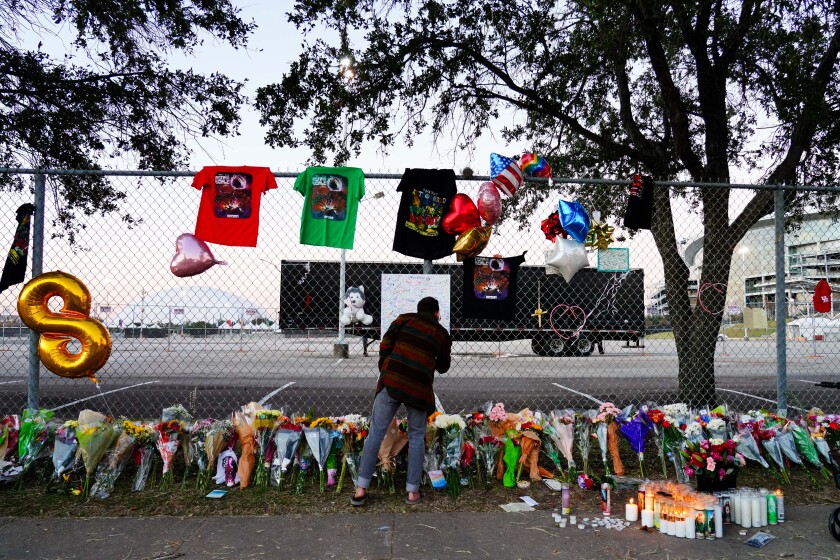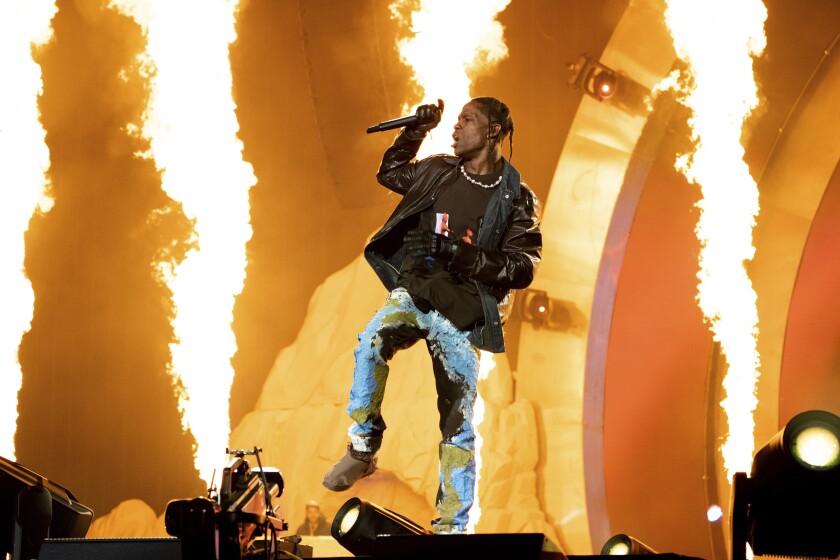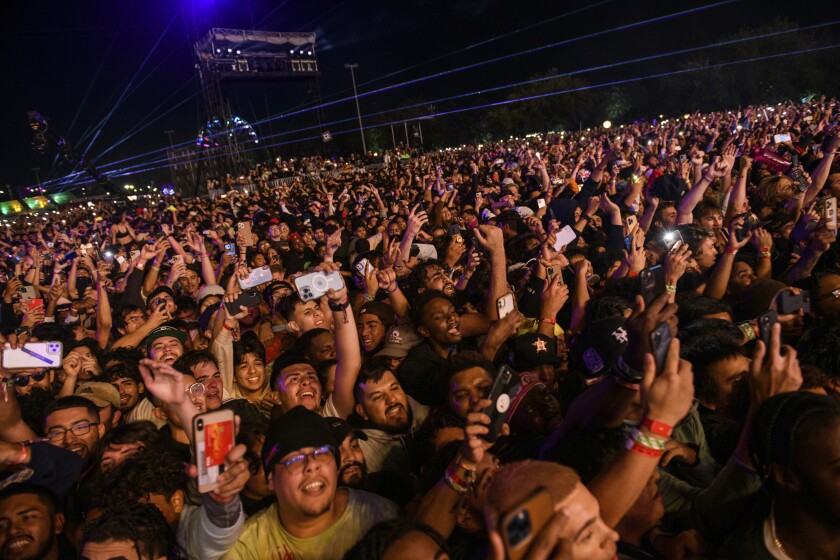|
TONIGHT: The CMA Awards are LIVE from Nashville
Astroworld organizers had extensive medical, security plans. Did they follow them?
A half-hour after rapper Travis Scott took the stage at 9 p.m. Friday, someone in the media pit called out for medical aid. In that instant, the Astroworld concert turned dangerous and surreal for Max Morbidelli, a 24-year-old former firefighter who was in the crowd with his sister.
“I jumped the barricade and found a girl who was passed out, supine and very clearly cyanotic, or blue,” said Morbidelli, an Advanced Emergency Medical Technician and graduate student at Auburn University in Alabama. The woman wasn’t breathing, didn’t have a pulse and no medical staff was visible, Morbidelli said. He started CPR.
“The scene was unimaginably chaotic,” he said. “The music was so loud. There were lights flashing. There are people tapping me on the shoulder asking me questions. It was overwhelming.”
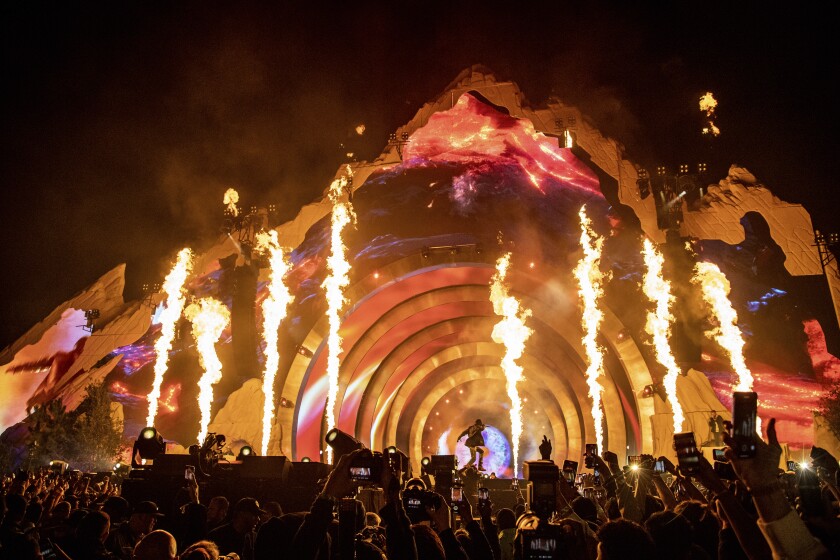
Morbidelli was caught up in unfolding chaos that had actually begun hours earlier when fans breached a barricade at the festival. Police intervened to bring things under control, but when crowds surged again that night, injuries mounted so quickly that medical staff was overwhelmed. Some concertgoers passed out. Others were trampled. A few climbed fences and begged Scott to stop the show, to no avail. By the time he left the stage after 10 p.m., bodies were being carried out on stretchers.
Eight people died, ranging in age from 14 to 27. Two dozen were hospitalized and scores more were injured. On Monday, the Houston medical examiner released the victims’ names, but their autopsies were still pending as local police and fire officials investigate what caused the night to turn deadly. At least one security guard was treated with naloxone for opioid overdose after reporting being pricked in the neck with a needle, Police Chief Troy Finner said, leading police to launch both homicide and narcotics investigations.
Multiple lawsuits have been filed against Scott and Astroworld organizers by those injured in the melee as questions have arisen over why the crowd surged and why it wasn’t contained during a day of unruliness. Some authorities also questioned why Scott continued to perform even as people fell unconscious and at least one ambulance appeared in front of the stage.
Before the concert, organizers had presented Houston police and first responders with two lengthy plans: A medical plan by New York City-based ParaDocs Worldwide Inc., and a security plan by Austin-based promoter ScoreMore Shows addressing the potential emergency.
“Based on the site’s layout and numerous past experiences, the potential for multiple alcohol/drug-related incidents, possible evacuation needs, and the ever-present threat of a mass casualty situation are identified as key concerns,” the security plan said.
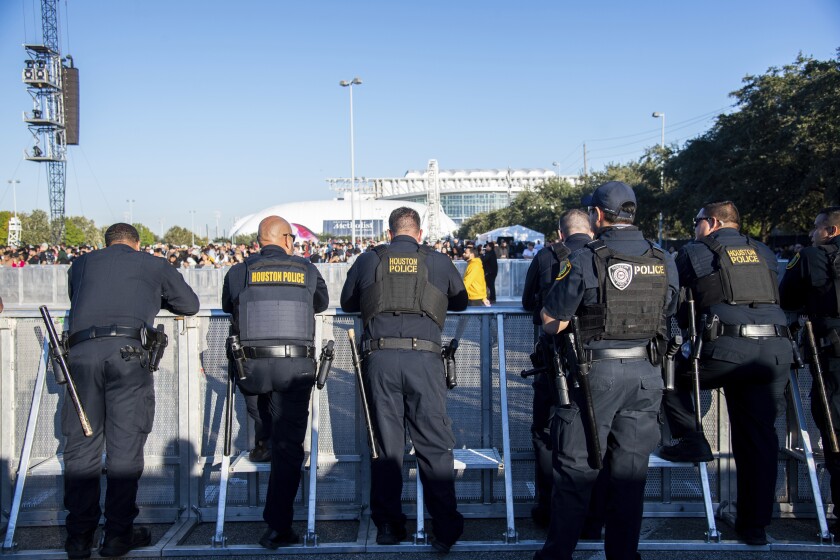
“The key in properly dealing with this type of scenario is proper management of the crowd from the minute the doors open,” the report stated. “Crowd management techniques will be employed to identify potentially dangerous crowd behavior in its early stages in an effort to prevent a civil disturbance/riot.”
Concert safety consultant Paul Wertheimer has been studying such tragedies since 1979, when he was an on-site investigator the night 11 people were trampled to death at a Cincinnati concert by the Who.
“What caught my attention,” Wertheimer said of the Astroworld plans, “is there’s no mention of crowd management of the audience in front of the stage. It’s not even addressed. Neither is moshing, crowd surfing or stage diving. Neither do the terms ‘crowd crush,’ ‘crowd surge,’ ‘crowd collapse’ or ‘panic’ appear anywhere.”
The medical plan estimated 70,000 would attend the concert, which was permitted for 50,000, according to Houston Fire Chief Samuel Peña. He said the outdoor space at NRG Park where the festival was held adjacent to an arena could have held 200,000, but that the event was permitted using a “more conservative” capacity formula as if it was being held indoors.
“In that venue, it’s a gray area,” he said of capacity limits. “That’s something that needs to be addressed.”
Peña said it’s not clear how many people attended the concert. He requested a manifest of how many Astroworld tickets were sold, including 34,000 that were scanned, plus VIP and comp tickets. But others were caught climbing the fences to gain illicit entry during the day, he said. He had stationed about a dozen fire staff on-site in case of an emergency, but it was Astroworld’s responsibility to protect those in attendance.
“It’s not what we do, to go to these events and set up a first aid station,” Peña said.
ScoreMore and concert organizer Live Nation did not respond to requests for comment Monday. They released a statement saying they had provided video footage to investigators and were cooperating, “to get everyone the answers they are looking for.”
ParaDocs Worldwide Inc. released a statement disputing allegations it lacked medical staff and equipment. It said it has been “providing medical care for large venue events” for more than seven years, that their emergency medical staff have a dozen years experience on average and have successfully treated more than 300,000 people.
“We were prepared for the size of the venue and the expected audience with a trained team of medics,” the statement said. “There were ample resources of medication, remedies, treatments and supplies, and the demand and usage did not exceed the onsite stock. From the beginning, the event occurred with a standard course of care throughout the day. The multiple cardiac arrests occurred during the last set in the evening.”
Following the tragedy, Scott released a statement promising to pay for victims’ funerals, assist with the investigation and provide therapy to those affected. Scott said in a video statement on Instagram that he did not realize the extent of the emergency, and noted that he typically stops his concerts so injured fans can reach safety.
“I could just never imagine the severity of the situation,” he said.
But concert attendees said Astroworld security deteriorated within hours of the doors opening around noon on Friday.
Houston Police Chief Troy Finner tweeted that he met with Scott “for a few moments last Friday prior to the main event” and “expressed my concerns regarding public safety.” Finner said Scott’s head of security was also at the meeting, which was “brief and respectful.”
Houston disc jockey Michael Pierangeli, 30, who was attending Astroworld for the third time, arrived shortly before noon and said he noticed people sneaking in.
“A lot of people didn’t have wristbands,” signifying they had tickets, he said.
During afternoon shows, Pierangeli said the crowds felt unsafe.
“The vibe was just off,” he said. “It wasn’t actually moshing pits. People were just pushing each other. Walls were getting made and people were getting sucked in. I’m normally in the mix. I just realized it was too much.”
By 2 p.m, hundreds of fans had breached a VIP entrance, just as they breached an area at the last Astroworld in 2019. But police got the area under control and decided not to shut anything down.
“They made some arrests there and they handled that issue,” Peña said.
At about 4:30 p.m., Morbidelli, the EMT, said he started feeling overwhelmed by the density of the crowd as Houston rapper Don Toliver appeared on a smaller stage.
“I ended up grabbing my sister in a bear hug and pushing our way out of the crowd to a barrier and I lifted her up and over,” he said.
Another man in the crowd said he forced his way to the front of the crowd, where security had to lift him over a fence to escape.
At about 8:30 p.m., a countdown appeared on the concert’s big screen, ticking down the minutes to the show. As the crowd pressed in, Madeline Eskins, 23, an ICU nurse who lives north of Houston, fainted. Her boyfriend got someone to help him lift her up in the air and the crowd surfed her, unconscious, over a fence into a less crowded VIP area where she awoke to find emergency personnel woefully unprepared.
People were trying to hop over the fence. Security guards were dropping off more people — some bleeding from their noses or mouths — and then returning to pluck more people from the crowd.
One young man’s eyes rolled back into his head.
“Has ANYBODY checked a pulse?” Eskins yelled to a security guard, and she heard him say no.
Eskins checked the man’s pulse and shone a flashlight in his eyes: no response. She instructed the security guard to take him out of the VIP area for urgent medical assistance. She saw other security guards bring in bodies, including three in cardiac arrest, she said. A handful of medical staff was on-site — not nearly enough to aid the seriously injured, she said.
When she asked for an automated external defibrillator, an electronic pad used to treat heart attacks, a medic said they only had one and gestured to a woman whose
the shirt was ripped open as other medics gave CPR.
As Eskins gave CPR to a man struggling to breathe, she asked a member of the event medical staff to check his carotid or femoral pulse, but he didn’t know-how.
“Travis acknowledged that someone in the crowd needed an ambulance and was passed out,” Eskins said. “He just kept going.”
The chaos accelerated as Scott took to the stage and launched into his first track: “Escape Plan.”
“Within the first seconds of the first song, people began to drown — in other people,” Seanna Faith McCarty, 21, a festival-goer from the Houston suburb of Katy, wrote on Instagram. “The rush of people became tighter and tighter.”
Gasping for breath, McCarty and her friend, Taylor Grace, realized they had to get out. But there was nowhere to go. As the shoving became more intense, “people began to choke one another as the mass swayed,” she wrote. “Our lungs were compressed between the bodies of those surrounding us.”
Seeing security just a few feet away in a walkway, McCarty and other festival-goers began to scream.
“Hundreds of people ripped their vocal cords apart screaming for help, but we were not heard,” she wrote. “One person fell, or collapsed … A hole opened in the ground. It was like watching a Jenga Tower topple.”
McCarty said she lost sight of Grace and was pushed away from a rail and into the crowd of people, toward the edge of a sinkhole of people. She looked down at a man’s face — only to lose the face in what she described as a “floor of bodies” with “two layers of fallen people above them.”
At one point, McCarty lost her balance and nearly fell. She yelled to a man, who pulled her up. Eventually, she was able to get to the back of the crowd. A man pulled her over a guardrail and she spotted a cameraman on an elevated platform, eyes fixed on the stage.
She climbed a ladder and pointed to the hole, telling him people were dying. He told her to get off the platform. Another man grabbed her arm and told her he would push her off the 15-foot platform if she didn’t get down.
“I was in disbelief,” she wrote. “Here were two people that could actually do something. Had the power to do something. Cut the camera, call in backup, pause something. They did nothing.”
A video of the incident went viral over the weekend.
At the same time, as Morbidelli performed CPR on a breathless woman, two concerts medical staff in red shirts appeared with a backboard and no other life-saving equipment. One attempted to take over compressions, he said, but “it was very obvious that he was inexperienced at CPR. He was doing it very shallow and way too fast. One of the bystanders even told him to slow down. Once that happened, the medic yelled to see who knew CPR. And I stepped in and took over again.”
“I wasn’t sure what their plan was, so I just snapped,” Morbidelli said. “I yelled to one of the medics to get ready to put her on the backboard, so she was ready to be moved and we were not wasting any time. We rolled her onto her left side, pushed the backboard under her, and rolled her on. And that’s when I realized the backboard had no straps. I was shocked.”
A group of officers in bulletproof vests arrived and attempted to lift the woman on the backboard over a barricade, he said.
“Usually, there’s someone who’s at the head of the patient coordinating the lifting and transport. There was none of that. They balanced her on the barricade. But there was some miscommunication between the people at the head of the backboard and the people at the feet of the board, and the patient fell,” he said. “It was like slow motion. I watched her fall and hit the ground. I just fell to my knees and started crying.”
The woman was later identified as 22-year-old Texas A&M senior Bharti Shahani. She remains in intensive care at Houston Methodist Hospital, a spokeswoman said Tuesday.
“Dropping her like that was an act of pure negligence. That is the worst thing that can happen to anyone in the emergency medical field,” Morbidelli said.
Peña said event medical staff were “quickly overwhelmed.” At 9:38 p.m., he said local officials declared a mass casualty event, sending in SWAT, paramedics, and several dozen ambulances to treat concertgoers who had collapsed.
Yet Scott continued to perform.

“Everybody that’s there has a responsibility, even the artist. They have the stage, they have the microphone, they have the attention of the crowd,” Peña said, noting that, “at one point there was a pause, maybe when the ambulance was trying to drive through the crowd,” when Scott could have “turned on the lights and said I’m not going to continue the show.”
Instead, Pierangeli said he watched Drake join Scott onstage as an ambulance parked in the crowd trying to treat the injured.
“Kids were standing atop the ambulance, dancing, while obviously, the ambulance is trying to save people,” he said.
Nine-year-old Ezra Blount attended the concert with his father, Treston Blount, who was holding the boy on his shoulders.
“He kept saying he couldn’t breathe, he couldn’t breathe and he passed out,” said Treston Blount’s mother, Tricia Blount, 52, a retired nurse in Humble, Texas.
She said Ezra “got trampled a lot. He’s dealing with a lot of severe injuries at this time. He has to swell in the brain, most of his organs have been damaged, he had a cardiac arrest.”
“He’s a survivor. With God’s help, he can pull through,” Blount said. “There are a lot of other people who are still in the hospitals and we’re thinking of them, too.”
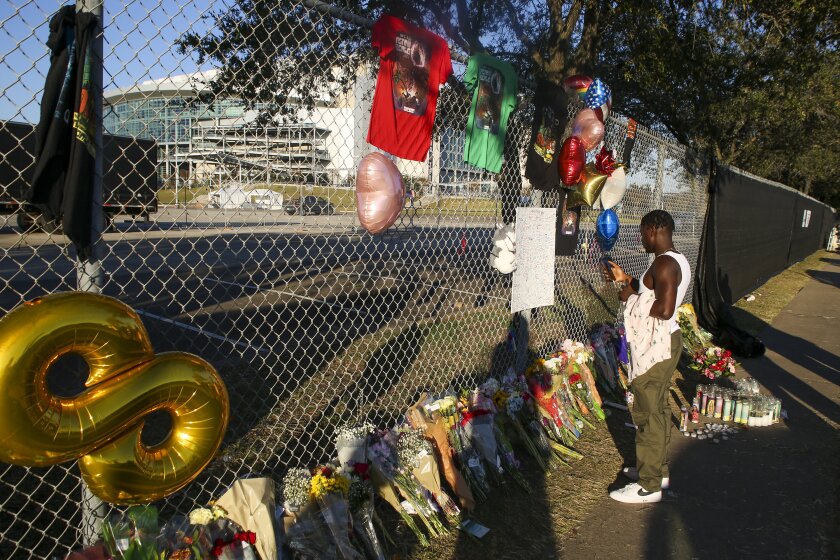
Lina Hidalgo, chief executive for Houston’s Harris County which owns NRG Park, arrived at 1:30 a.m. and met with families searching for lost loved ones. She has since called for an independent investigation into what went wrong.
“There should be a more detailed plan somewhere,” she said. “Was there anything more systemic that needed to be done better? Is the plan supposed to be so vague? There needs to be a question of was this tragedy a result of circumstances beyond the control of those involved?”
Hidalgo noted that Astroworld organizers’ plans didn’t show where security guards were deployed or how many were in the crowd.
“I don’t know how quickly everybody knew that people were dying. The plan says people are supposed to be in communication but were the communication lines open enough?” she asked. “There was a recognition that there had been an incident at the concert. When did they know?”
Hidalgo said she spoke Monday with the county medical examiner, who told her it will take weeks to get toxicology results, determine the victims’ causes of death, and whether there was foul play.
“There are families, all of these people wanting answers: the community, the country. And they deserve them,” she said. “If there’s something that needed to be done better, that needs to be addressed ahead of other events.”
Source: www.latimes.com
WANTED: Suspect responsible for Forgery
|
House of Gucci – official trailer
Riqueza. Poder. Estilo.
La familia Gucci lo tenía todo.
SOLO EN CINE 24 DE NOVIEMBRE
House of Gucci está inspirada en la impactante historia real de la familia detrás del imperio de la moda italiano. Cuando Patrizia Reggiani (Lady Gaga), una forastera de origen humilde, se casa con un miembro de la familia Gucci, su ambición desenfrenada comienza a desentrañar el legado familiar y desencadena un espiral temerario de traición, decadencia, venganza y, en última instancia… asesinato.
Director: Ridley Scott
Guión: Becky Johnston and Roberto Bentivegna
Historia: Becky Johnston
Basado en el libreo: “The House of Gucci” por Sara Gay Forden
Productores: Ridley Scott, p.g.a., Giannina Scott, p.g.a., Kevin J. Walsh, p.g.a., Mark Huffam, p.g.a.
Productores Ejecutivos: Kevin Ulrich, Megan Ellison, Aidan Elliott, Marco Valerio Pugini, Aaron L. Gilbert, Jason Cloth
Elenco: Lady Gaga, Adam Driver, Jared Leto, Jeremy Irons, Jack Huston, with Salma Hayek and Al Pacino
Clasificada R por lenguaje, contenido sexual, desnudez y violencia breve
WANTED: Suspect responsible for Indecency with a child
|
Presentan demanda contra Travis Scott, Live Nation y otros luego de la tragedia del Astroworld Festival
Una demanda fue presentada luego de la tragedia del Festival Astroworld que dejó ocho personas muertas y decenas de heridos en Houston el viernes por la noche.
Un asistente al concierto que resultó herido está demandando al rapero y productor Travis Scott, quien fue el organizador del Festival Astroworld, así como a la compañía de entretenimiento Live Nation, la promotora de conciertos Scoremore y otros involucrados en el evento, según la demanda obtenida por CNN.
Temen que aumenten los fallecidos en el festival Astroworld.Manuel Souza, quien está siendo representado por el bufete de abogados Kherkher García, “sufrió graves lesiones corporales cuando la multitud descontrolada en el concierto lo tiró al suelo y lo pisoteó”, según la demanda presentada en el condado de Harris, Texas.
“Los acusados no planificaron ni llevaron a cabo correctamente el concierto de manera segura”, continúa la demanda.
“En cambio, ignoraron conscientemente los riesgos extremos de daño a los asistentes al concierto y, en algunos casos, alentaron y fomentaron activamente comportamientos peligrosos. Su negligencia grave causó lesiones graves al demandante”.
El monto de la demanda por Astroworld
Se prefiere un juicio con jurado para determinar la cantidad exacta de daños, según la demanda, pero Souza busca “una compensación monetaria de más de US$ 1.000.000”.
CNN se ha comunicado con Scott, Live Nation y Scoremore para comentar sobre la demanda.
“Con el corazón roto por los que perdimos y los afectados en Astroworld anoche”, dijo Live Nation, la compañía responsable de organizar el Festival Astroworld, en un comunicado. “Continuaremos trabajando para brindar la mayor cantidad de información y asistencia posible a las autoridades locales mientras investigan la situación”.
Live Nation es un promotor de conciertos, operador de salas y propietario de Ticketmaster. Según su sitio web, vende 500 millones de entradas para conciertos y festivales cada año.
Cronología de los eventos en la noche de la tragedia
La multitud del viernes por la noche en el Festival Astroworld, con entradas agotadas, estaba tan aglomerada que cuando algunos miembros de la audiencia fueron empujados hacia el escenario, dijeron a CNN, fueron aplastados hasta el punto que no podían respirar y se desmayaron.
Los asistentes al concierto describieron el evento como traumatizante, y muchos testigos dijeron que vieron cuerpos sin vida pisoteados en medio del caos. Los que sobrevivieron tuvieron que abrirse paso entre la multitud mientras continuaba la música.
Scott subió al escenario para su presentación poco después de las 9 pm. Las autoridades dijeron que se enteraron de las oleadas de público al principio de su presentación y recibieron los primeros informes de lesiones aproximadamente a las 9:30 pm.
No está claro lo que Scott vio desde el escenario y si estaba al tanto de las condiciones de la multitud en ese momento, pero continuó actuando hasta aproximadamente las 10:10 pm. Eso es aproximadamente 40 minutos después de que se informaron los primeros reportes de lesiones a las autoridades y poco más de 30 minutos después de que declararan el concierto “evento de múltiples víctimas”, según los tiempos dados por el jefe de bomberos de Houston, Samuel Peña, en una conferencia de prensa el sábado por la mañana.
El video de la transmisión en vivo del concierto también mostró a Scott pausando su actuación y mirando con aparente confusión mientras una ambulancia se acercaba a la multitud. EL comenzó a actuar nuevamente, pero luego detuvo el concierto.
Lo que dijo Travis Scott
Scott dio su primera declaración ante la cámara en un video publicado en su cuenta de Instagram el sábado por la noche.
“Honestamente, estoy devastado”, dijo Scott mientras suspiraba repetidamente y se frotaba la frente. “De hecho, estamos trabajando en este momento para identificar a las familias y poder ayudarlas en este momento difícil”.







Algunos asistentes al concierto han criticado a los organizadores por continuar el espectáculo incluso cuando a las personas que no respondían se les estaba aplicando resucitación cardiopulmonar y se las llevaban, pero Scott indicó que no estaba al tanto de la gravedad de las cosas. “Cada vez que pude darme cuenta, ya sabes, de cualquier cosa que estaba sucediendo, ya sabes, simplemente detuve mi espectáculo y, ya sabes, los ayudé a conseguir la ayuda que necesitaban”.
El Departamento de Policía de Houston tuiteó el domingo que la investigación de la tragedia está activa y “en sus primeras etapas”.
La demanda alega, “Scott anima activamente a sus fans a ‘enfurecerse’ en sus conciertos. Su expreso aliento a la violencia ha resultado previamente en violencia grave en numerosos conciertos pasados”.
También cita un tuit de Scott eliminado desde entonces en respuesta a las quejas de los fans sobre la rápida venta de entradas de este concierto: “¡¡¡¡SEGUIMOS COLANDO A LOS SALVAJES!!!!!”.
Source: cnnespanol.cnn.com
Texas Drilling Permit and Completion Statistics for October 2021
The Railroad Commission of Texas issued a total of 768 original drilling permits in October 2021 compared to 395 in October 2020. The October 2021 total includes 689 permits to drill new oil or gas wells, 10 to re-enter plugged wellbores, and 60 for re-completions of existing wellbores.
The breakdown of well types for original drilling permits in October 2021 is 174 oil, 69 gas, 479 oil or gas, 39 injection, and seven other permits.
In October 2021, Commission staff processed 597 oil, 95 gas and 341 injection completions for new drills, re-entries and re-completions, compared to 777 oil, 196 gas, and 119 injection completions in October 2020.
Total well completions processed for 2021 year-to-date for new drills, re-entries and re-completions are 7,980 compared to 12,901 recorded during the same period in 2020.
TABLE 1 – OCTOBER 2021 TEXAS OIL AND GAS NEW DRILLING PERMITS AND COMPLETIONS BY RAILROAD COMMISSION OF TEXAS DISTRICT*
| DISTRICT | PERMITS TO DRILL NEW OIL/GAS HOLES | NEW OIL COMPLETIONS | NEW GAS COMPLETIONS |
| (1) SAN ANTONIO AREA | 81 | 23 | 9 |
| (2) REFUGIO AREA | 41 | 29 | 6 |
| (3) SOUTHEAST TEXAS | 17 | 11 | 3 |
| (4) DEEP SOUTH TEXAS | 11 | 1 | 3 |
| (5) EAST CENTRAL TX | 5 | 0 | 0 |
| (6) EAST TEXAS | 28 | 3 | 11 |
| (7B) WEST CENTRAL TX | 23 | 12 | 0 |
| (7C) SAN ANGELO AREA | 43 | 38 | 0 |
| (8) MIDLAND | 370 | 382 | 38 |
| (8A) LUBBOCK AREA | 28 | 9 | 0 |
| (9) NORTH TEXAS | 30 | 11 | 2 |
| (10) PANHANDLE | 12 | 4 | 3 |
| TOTAL | 689 | 523 | 75 |
Shell Restores Production at Mars and Ursa in the Gulf of Mexico
Shell Offshore Inc., a subsidiary of Royal Dutch Shell plc, has safely and successfully re-started production at our Mars and Ursa platforms in the US Gulf of Mexico and began exporting oil and gas through the West Delta-143 (WD-143) “A” facility.
“Our Hurricane Ida recovery efforts are the latest example of how our people come together with great determination to tackle the biggest challenges of the day,” said Zoe Yujnovich, Upstream Director. “We are proud to have safely restored our full production in the US Gulf of Mexico, where the barrels are among the lowest GHG intensity in the world.”
On October 1, Shell safely and successfully re-started production at our Olympus platform in the Gulf of Mexico and began exporting oil and gas through the West Delta-143 (WD-143) “C” facility. When Mars and Ursa are fully ramped up, we will have 100% of Shell-operated production in the Gulf of Mexico back online, ahead of schedule from our initial estimates.
Source: www.shell.com
US Department of Labor issues emergency temporary standard to protect workers from coronavirus
The U.S. Department of Labor’s Occupational Safety and Health Administration today announced a new emergency temporary standard to protect more than 84 million workers from the spread of the coronavirus on the job. The nation’s unvaccinated workers face grave danger from workplace exposure to coronavirus, and immediate action is necessary to protect them.
Under this standard, covered employers must develop, implement and enforce a mandatory COVID-19 vaccination policy, unless they adopt a policy requiring employees to choose to either be vaccinated or undergo regular COVID-19 testing and wear a face covering at work.
Since 2020, the coronavirus has led to the deaths of 750,000 people in the U.S., and the infection of millions more, making it the deadliest pandemic in the nation’s history. Many of the people killed and infected by this virus were workers whose primary exposures occurred at their jobs. OSHA estimates that this rule will save thousands of lives and prevent more than 250,000 hospitalizations due to workplace exposure to COVID-19 over the course of the ETS.
“COVID-19 has had a devastating impact on workers, and we continue to see dangerous levels of cases,” said U.S. Labor Secretary Marty Walsh. “We must take action to implement this emergency temporary standard to contain the virus and protect people in the workplace against the grave danger of COVID-19. Many businesses understand the benefits of having their workers vaccinated against COVID-19, and we expect many will be pleased to see this OSHA rule go into effect.”
The emergency temporary standard covers employers with 100 or more employees – firm or company-wide – and provides options for compliance. The ETS also requires employers to provide paid time to workers to get vaccinated and to allow for paid leave to recover from any side effects.
The ETS also requires employers to do the following:
- Determine the vaccination status of each employee, obtain acceptable proof of vaccination status from vaccinated employees and maintain records and a roster of each employee’s vaccination status.
- Require employees to provide prompt notice when they test positive for COVID-19 or receive a COVID-19 diagnosis. Employers must then remove the employee from the workplace, regardless of vaccination status; employers must not allow them to return to work until they meet the required criteria.
- Ensure each worker who is not fully vaccinated is tested for COVID-19 at least weekly (if the worker is in the workplace at least once a week) or within 7 days before returning to work (if the worker is away from the workplace for a week or longer).
- Ensure that, in most circumstances, each employee who has not been fully vaccinated wears a face covering when indoors or when occupying a vehicle with another person for work purposes.
The emergency temporary standard does not require employers to pay for testing. Employers may be required to pay for testing to comply with other laws, regulations, collective bargaining agreements, or other collectively negotiated agreements. Employers are also not required to pay for face coverings.
“While vaccination remains the most effective and efficient defense against COVID-19, this emergency temporary standard will protect all workers, including those who remain unvaccinated, by requiring regular testing and the use of face coverings by unvaccinated workers to prevent the spread of the virus,” said Deputy Assistant Secretary of Labor for Occupational Safety and Health Jim Frederick. “As part of OSHA’s mission to protect the safety and health of workers, this rule will provide a roadmap to help businesses keep their workers safe.”
OSHA is offering robust compliance assistance to help businesses implement the standard, including a webinar, frequently asked questions and other compliance materials.
The ETS will cover two-thirds of the nation’s private-sector workforce. In the 26 states and two territories with OSHA State Plans, the ETS will also cover public sector workers employed by state and local governments, including educators and school staff.
Leading companies, including major airlines, manufacturers and retailers, have taken similar actions in recent months – adopting vaccine requirements or regular testing as necessary measures to protect their workers and customers.
The ETS is effective immediately upon its publication in the Federal Register. Employers must comply with most requirements within 30 days of publication and with testing requirements within 60 days of publication.
The ETS also serves as a proposal for normal rulemaking for a final standard. OSHA is seeking comment on all aspects of this ETS and whether the agency should adopt it as a final standard.
OSHA will continue to monitor the status of COVID-19 infections and deaths, as the number of vaccinated people in workplaces and the general public increases and the pandemic evolves. OSHA will update the ETS should the agency find a grave danger no longer exists for the covered workforce (or some portion thereof), or new information indicates a change in measures is needed.
Under the Occupational Safety and Health Act of 1970, employers are responsible for providing safe and healthful workplaces for their employees. OSHA’s role is to help ensure these conditions for America’s workers by setting and enforcing standards, and providing training, education and assistance.
Source: www.osha.gov
Governor Abbott Discusses Impact Of Border Crisis On Texas Communities With Local Law Enforcement In Midland
 Governor Greg Abbott today held a roundtable discussion with local law enforcement in Midland about the ongoing crisis at the southern border and its reverberating impact in communities throughout Texas. The Governor was joined by Texas Department of Public Safety (DPS) Director Steven McCraw, Midland County Judge Terry Johnson, Midland County Sheriff David Criner, and law enforcement representatives from Upton, Ector, Tom Green, Dawson, Martin, Howard, and Andrews counties.During the discussion, Governor Abbott thanked local law enforcement for keeping Texans safe and offered his support in their efforts to mitigate the impact of the border crisis in their communities. Sheriffs thanked the state for being proactive and for coming up with innovative ideas to address this ongoing crisis in the federal government’s absence.
Governor Greg Abbott today held a roundtable discussion with local law enforcement in Midland about the ongoing crisis at the southern border and its reverberating impact in communities throughout Texas. The Governor was joined by Texas Department of Public Safety (DPS) Director Steven McCraw, Midland County Judge Terry Johnson, Midland County Sheriff David Criner, and law enforcement representatives from Upton, Ector, Tom Green, Dawson, Martin, Howard, and Andrews counties.During the discussion, Governor Abbott thanked local law enforcement for keeping Texans safe and offered his support in their efforts to mitigate the impact of the border crisis in their communities. Sheriffs thanked the state for being proactive and for coming up with innovative ideas to address this ongoing crisis in the federal government’s absence.
“The Biden administration’s border crisis doesn’t just affect Texans living along the border; it’s being felt by communities throughout Texas,” said Governor Abbott. “With an uptick in deadly drugs like fentanyl, dangerous gang activity, and human trafficking across our state, the State of Texas continues to work closely with local law enforcement to solve these challenges. Texas’ unprecedented response to secure the border and combat the crisis would not be possible without local law enforcement partners here in West Texas and across the state, and we continue to ensure they have the resources needed to keep Texans safe.”
Governor Abbott has taken significant action to secure the border in the wake of the federal government’s inaction. Those actions include:
- Signing laws that provide $3 billion in funding for Texas’ border security efforts
- Launching Operation Lone Star and deploying thousands of National Guard soldiers and Department of Public Safety troopers
- Creating a system to arrest and jail illegal migrants trespassing or committing other state crimes in Texas
- Signing a budget authorization to build the border wall in Texas
- Signing a law to make it easier to prosecute smugglers bringing people into Texas
- Signing 9 laws cracking down on human trafficking in Texas
- Signing a law enhancing penalties for the manufacturing and distribution of fentanyl
- Issuing a disaster declaration for the border crisis
- Issuing an executive order preventing non-governmental entities from transporting illegal immigrants
- Taking legal action to enforce the Remain in Mexico and Title 42 policies in Texas
Source: gov.texas.gov





